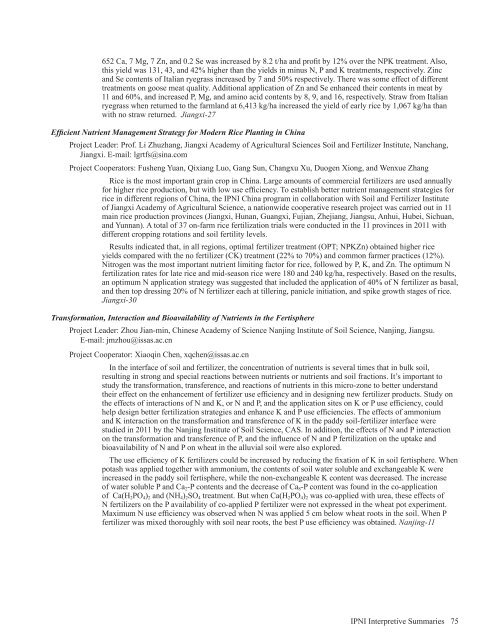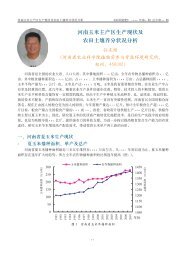Americas and Oceania Group - International Plant Nutrition Institute
Americas and Oceania Group - International Plant Nutrition Institute
Americas and Oceania Group - International Plant Nutrition Institute
Create successful ePaper yourself
Turn your PDF publications into a flip-book with our unique Google optimized e-Paper software.
652 Ca, 7 Mg, 7 Zn, <strong>and</strong> 0.2 Se was increased by 8.2 t/ha <strong>and</strong> profit by 12% over the NPK treatment. Also,<br />
this yield was 131, 43, <strong>and</strong> 42% higher than the yields in minus N, P <strong>and</strong> K treatments, respectively. Zinc<br />
<strong>and</strong> Se contents of Italian ryegrass increased by 7 <strong>and</strong> 50% respectively. There was some effect of different<br />
treatments on goose meat quality. Additional application of Zn <strong>and</strong> Se enhanced their contents in meat by<br />
11 <strong>and</strong> 60%, <strong>and</strong> increased P, Mg, <strong>and</strong> amino acid contents by 8, 9, <strong>and</strong> 16, respectively. Straw from Italian<br />
ryegrass when returned to the farml<strong>and</strong> at 6,413 kg/ha increased the yield of early rice by 1,067 kg/ha than<br />
with no straw returned. Jiangxi-27<br />
Efficient Nutrient Management Strategy for Modern Rice <strong>Plant</strong>ing in China<br />
Project Leader: Prof. Li Zhuzhang, Jiangxi Academy of Agricultural Sciences Soil <strong>and</strong> Fertilizer <strong>Institute</strong>, Nanchang,<br />
Jiangxi. E-mail: lgrtfs@sina.com<br />
Project Cooperators: Fusheng Yuan, Qixiang Luo, Gang Sun, Changxu Xu, Duogen Xiong, <strong>and</strong> Wenxue Zhang<br />
Rice is the most important grain crop in China. Large amounts of commercial fertilizers are used annually<br />
for higher rice production, but with low use efficiency. To establish better nutrient management strategies for<br />
rice in different regions of China, the IPNI China program in collaboration with Soil <strong>and</strong> Fertilizer <strong>Institute</strong><br />
of Jiangxi Academy of Agricultural Science, a nationwide cooperative research project was carried out in 11<br />
main rice production provinces (Jiangxi, Hunan, Guangxi, Fujian, Zhejiang, Jiangsu, Anhui, Hubei, Sichuan,<br />
<strong>and</strong> Yunnan). A total of 37 on-farm rice fertilization trials were conducted in the 11 provinces in 2011 with<br />
different cropping rotations <strong>and</strong> soil fertility levels.<br />
Results indicated that, in all regions, optimal fertilizer treatment (OPT; NPKZn) obtained higher rice<br />
yields compared with the no fertilizer (CK) treatment (22% to 70%) <strong>and</strong> common farmer practices (12%).<br />
Nitrogen was the most important nutrient limiting factor for rice, followed by P, K, <strong>and</strong> Zn. The optimum N<br />
fertilization rates for late rice <strong>and</strong> mid-season rice were 180 <strong>and</strong> 240 kg/ha, respectively. Based on the results,<br />
an optimum N application strategy was suggested that included the application of 40% of N fertilizer as basal,<br />
<strong>and</strong> then top dressing 20% of N fertilizer each at tillering, panicle initiation, <strong>and</strong> spike growth stages of rice.<br />
Jiangxi-30<br />
Transformation, Interaction <strong>and</strong> Bioavailability of Nutrients in the Fertisphere<br />
Project Leader: Zhou Jian-min, Chinese Academy of Science Nanjing <strong>Institute</strong> of Soil Science, Nanjing, Jiangsu.<br />
E-mail: jmzhou@issas.ac.cn<br />
Project Cooperator: Xiaoqin Chen, xqchen@issas.ac.cn<br />
In the interface of soil <strong>and</strong> fertilizer, the concentration of nutrients is several times that in bulk soil,<br />
resulting in strong <strong>and</strong> special reactions between nutrients or nutrients <strong>and</strong> soil fractions. It’s important to<br />
study the transformation, transference, <strong>and</strong> reactions of nutrients in this micro-zone to better underst<strong>and</strong><br />
their effect on the enhancement of fertilizer use efficiency <strong>and</strong> in designing new fertilizer products. Study on<br />
the effects of interactions of N <strong>and</strong> K, or N <strong>and</strong> P, <strong>and</strong> the application sites on K or P use efficiency, could<br />
help design better fertilization strategies <strong>and</strong> enhance K <strong>and</strong> P use efficiencies. The effects of ammonium<br />
<strong>and</strong> K interaction on the transformation <strong>and</strong> transference of K in the paddy soil-fertilizer interface were<br />
studied in 2011 by the Nanjing <strong>Institute</strong> of Soil Science, CAS. In addition, the effects of N <strong>and</strong> P interaction<br />
on the transformation <strong>and</strong> transference of P, <strong>and</strong> the influence of N <strong>and</strong> P fertilization on the uptake <strong>and</strong><br />
bioavailability of N <strong>and</strong> P on wheat in the alluvial soil were also explored.<br />
The use efficiency of K fertilizers could be increased by reducing the fixation of K in soil fertisphere. When<br />
potash was applied together with ammonium, the contents of soil water soluble <strong>and</strong> exchangeable K were<br />
increased in the paddy soil fertisphere, while the non-exchangeable K content was decreased. The increase<br />
of water soluble P <strong>and</strong> Ca 2 -P contents <strong>and</strong> the decrease of Ca 8 -P content was found in the co-application<br />
of Ca(H 2PO 4 ) 2 <strong>and</strong> (NH 4 ) 2 SO 4 treatment. But when Ca(H 2 PO 4 ) 2 was co-applied with urea, these effects of<br />
N fertilizers on the P availability of co-applied P fertilizer were not expressed in the wheat pot experiment.<br />
Maximum N use efficiency was observed when N was applied 5 cm below wheat roots in the soil. When P<br />
fertilizer was mixed thoroughly with soil near roots, the best P use efficiency was obtained. Nanjing-11<br />
IPNI Interpretive Summaries 75

















